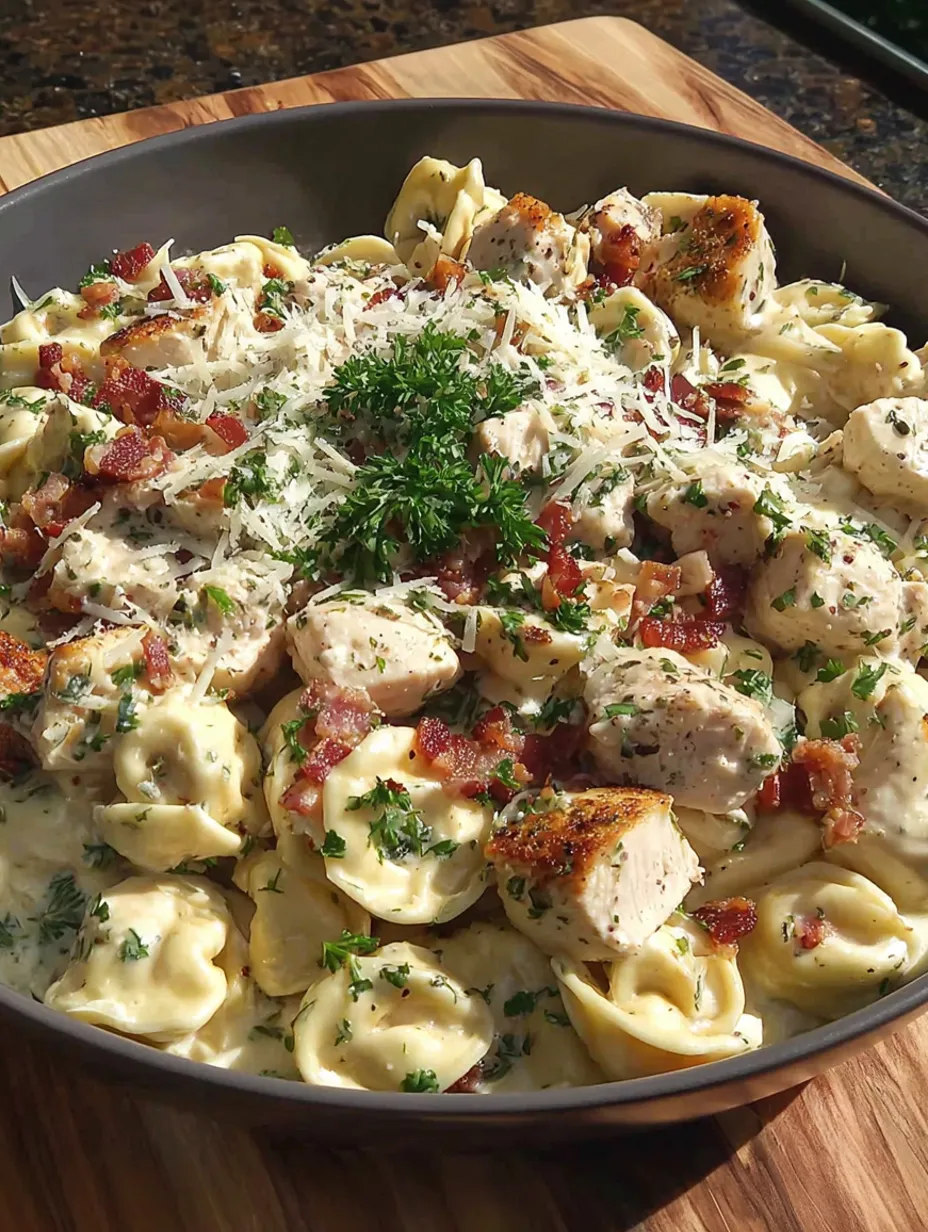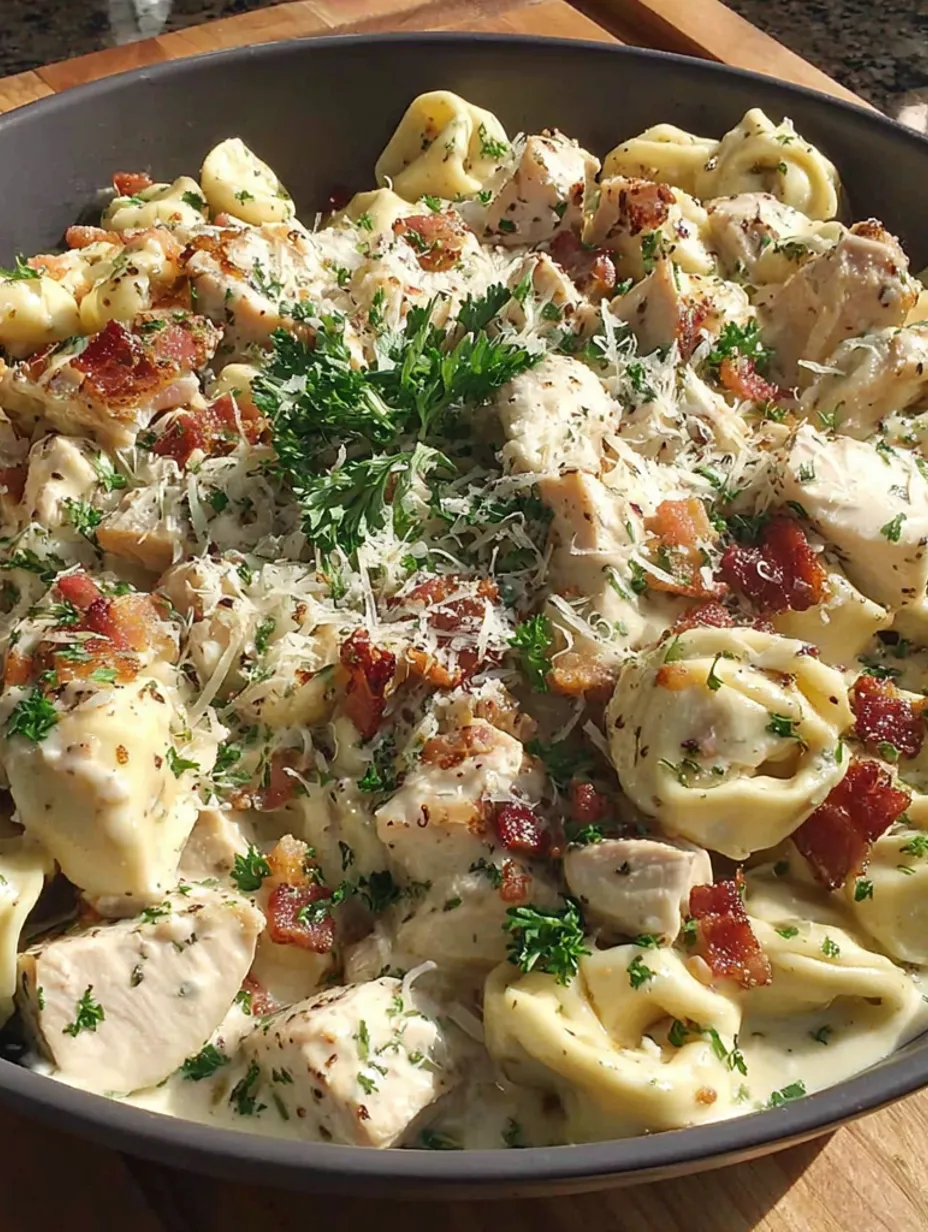 Bookmark
Bookmark
This Italian parmesan chicken tortellini combines tender, marinated chicken with cheese-filled pasta in a rich, creamy sauce that brings everything together perfectly. The Italian dressing marinade infuses the chicken with herbs and tang, while the homemade parmesan cream sauce coats every piece of tortellini with luxurious flavor. What makes this recipe particularly valuable is how it creates an impressive, restaurant-quality meal in under thirty minutes using straightforward techniques that work reliably every single time.
My neighbor shared this recipe after I complimented the amazing smells coming from her kitchen one evening. She'd been making variations of it for years, tweaking the sauce until it reached that perfect creamy consistency that coats the pasta without being too heavy. The first time I served it to my family, everyone assumed I'd ordered expensive takeout because it looked and tasted so sophisticated.
Ingredients
- 3 to 4 boneless, skinless chicken breasts: diced into uniform pieces for even cooking and easy eating
- 1 cup Italian dressing: using a quality brand with good herb flavor for the best marinade results
- 1/2 tablespoon onion powder: for savory depth
- 1/2 tablespoon garlic powder: for aromatic flavor
- 1/4 teaspoon black pepper: for subtle heat
- 1 tablespoon olive oil: for searing
- 12 oz package cheese tortellini: as fresh or frozen both work beautifully, choose your preferred filling
- 1 tablespoon olive oil: for tossing to prevent sticking
- 3 tablespoons real butter: essential for creating the roux base that thickens the sauce properly
- 2 tablespoons all-purpose flour: to thicken the sauce to the perfect consistency for coating pasta
- 2 cups heavy whipping cream: providing that signature restaurant-quality richness and texture
- 1 cup freshly shredded Parmesan cheese: melts more smoothly than pre-shredded varieties
- 1 cup freshly shredded mozzarella cheese: for creamy texture
- Salt and black pepper: to taste for seasoning balance
Step-by-Step Instructions
- Marinate the Chicken:
- Cut chicken breasts into uniform bite-sized pieces about 1 inch in diameter for consistent cooking. Combine the diced chicken with Italian dressing, onion powder, garlic powder, and black pepper in a medium bowl, ensuring every piece gets coated. Marinate for at least 15 minutes at room temperature, or up to 4 hours in the refrigerator for deeper flavors that really penetrate the meat.
- Cook the Chicken Perfectly:
- Heat 1 tablespoon olive oil in a large skillet over medium-high heat until it shimmers but doesn't smoke. Add the marinated chicken in a single layer without overcrowding, which would cause steaming instead of browning. Cook for 6 to 8 minutes, stirring occasionally, until the chicken reaches an internal temperature of 165°F and develops beautiful golden-brown edges that add flavor. Remove the cooked chicken to a clean plate and set aside.
- Prepare the Tortellini:
- Bring a large pot of generously salted water to a rolling boil. The water should taste like seawater for proper pasta seasoning. Add the tortellini and cook according to package directions until tender but still slightly firm to the bite. Fresh tortellini typically takes 2 to 3 minutes while frozen needs 5 to 7 minutes. Drain thoroughly in a colander and toss with a small amount of olive oil to prevent the pasta from sticking together.
- Create the Roux Foundation:
- Reduce the heat under your skillet to medium and add the butter, letting it melt completely until it starts to foam lightly. Sprinkle the flour evenly over the melted butter and whisk constantly for 1 to 2 minutes, creating a smooth roux that eliminates the raw flour taste. This step is crucial for a silky sauce texture, so don't rush it even though it seems simple.
- Add Cream and Build Thickness:
- Pour the heavy whipping cream into the roux mixture in a slow, steady stream while whisking constantly and vigorously to prevent any lumps from forming. Continue whisking as the mixture heats and gradually thickens to a gentle simmer. This process takes about 3 to 5 minutes, and you'll see the sauce coat the back of a spoon when it's ready. The gentle bubbling should be consistent but not aggressive.
- Melt the Cheese Properly:
- Remove the skillet completely from the heat source before adding any cheese. Add the shredded Parmesan and mozzarella cheeses gradually, stirring continuously with a wooden spoon or silicone spatula until both melt completely and create a smooth, luxurious sauce. The residual heat is perfect for melting without causing the proteins to seize up. Season carefully with salt and black pepper, tasting as you go since the cheeses already provide saltiness.
- Final Assembly:
- Return the cooked chicken and drained tortellini to the skillet with the cheese sauce. Using a large spoon or tongs, gently fold everything together with careful movements until each piece of pasta and every bit of chicken gets completely coated with the creamy sauce. Work slowly and deliberately to avoid breaking the delicate tortellini, which can burst if handled roughly.
 Bookmark
Bookmark
The key to this dish's restaurant quality lies in that homemade cream sauce, which transforms simple ingredients into something truly special. I learned the hard way that adding cheese while the pan is still on heat creates a grainy mess, but once you master the off-heat technique, you'll use it for every cheese sauce going forward.
Storage and Reheating Tips
Store leftover pasta covered in the refrigerator for up to three days in airtight containers. The sauce will thicken considerably when cold, which is completely normal. Reheat gently on the stovetop over low heat, adding a splash of cream or whole milk to restore the original creamy consistency. Stir frequently and patiently, as rushing with high heat will cause the sauce to separate. The dish comes back together beautifully with gentle warming and occasional stirring.
Ingredient Substitutions
Transform this recipe easily based on what you have available. Replace Italian dressing with a homemade mixture of olive oil, red wine vinegar, dried Italian herbs, minced garlic, and a pinch of sugar. Chicken thighs work wonderfully if you prefer richer, more flavorful meat that's harder to overcook. For the pasta, any stuffed variety like ravioli or agnolotti creates similar results, though cooking times will vary. Heavy cream can be replaced with half-and-half for a lighter version, though the sauce won't be quite as rich.
Creative Serving Suggestions
Serve this indulgent pasta in shallow, warmed bowls to keep everything at the perfect temperature longer. Crusty garlic bread or focaccia provides the ideal vehicle for soaking up every drop of that incredible sauce. A simple Caesar salad or mixed greens with balsamic vinaigrette cuts through the richness beautifully. Garnish each serving with freshly chopped basil, a generous sprinkle of additional Parmesan cheese, and perhaps a light dusting of freshly cracked black pepper for visual appeal and extra flavor.
Flavor Variations
Transform this base recipe into countless variations that keep dinner interesting. Add chopped sun-dried tomatoes during the sauce-making stage for Mediterranean flair and tangy sweetness. Fresh spinach wilts perfectly when stirred in with the final assembly, adding color and nutrition. Roasted red peppers or sautéed mushrooms provide different textures and flavors. For heat lovers, red pepper flakes or a splash of hot sauce mixed into the cream creates a spicy version that's absolutely addictive.
 Bookmark
Bookmark
Frequently Asked Questions About Recipes
- → Can I use fresh or frozen tortellini?
Either works great! Fresh tortellini cooks faster (2-3 minutes), while frozen takes 5-7 minutes. Adjust cooking time according to package directions.
- → What can I substitute for Italian dressing?
Make your own with olive oil, vinegar, Italian herbs, garlic, and a pinch of sugar. Or simply season the chicken with Italian seasoning, garlic, and olive oil.
- → Can I use jarred alfredo sauce instead of making it?
Yes! Use two 15 oz jars of alfredo sauce to save time. Just heat it through and toss with the chicken and pasta.
- → How do I prevent the sauce from being too thick?
If the sauce gets too thick, thin it with a little pasta water or extra cream. Stir constantly while making the sauce to control consistency.
- → Can I add vegetables to this dish?
Absolutely! Spinach, sun-dried tomatoes, broccoli, or mushrooms all work well. Add them when you add the chicken back to the pan.
- → How long can I marinate the chicken?
Minimum 15 minutes for quick flavor, or up to 4 hours in the refrigerator for deeper flavor. Don't marinate longer than 8 hours as the acids can break down the meat.
